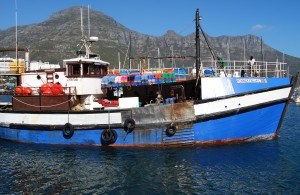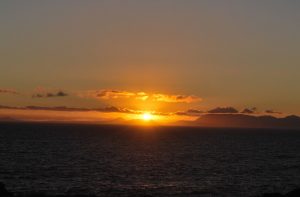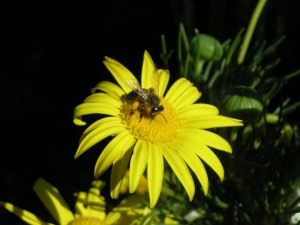I find it absolutely astounding that Donald Trump, a man who is running for the highest office of arguably the most powerful country on Earth, and who has lived through Chernobyl, Three Mile Island and Fukushima, can dismiss nuclear confrontation with a metaphorical flick of his wrist. This is what I know about the rebellious atom:
Early in the morning of 1 March 1954, a 15-megaton nuclear blast, which was detonated by the US military, and which was codenamed Bravo, caused a blinding mushroom cloud of ferocious heat to soar high into the atmosphere above Bikini Atoll in the Pacific Ocean, generating winds of searing intensity that irradiated the ocean and atolls surrounding the the test site. The Rongelap and Ailinginae Atolls, which were situated directly under a deadly cloud of fallout ash, were covered in a thick blanket of white radioactive dust.
 This < gritty synthetic snow also rained down onto the deck of a Japanese tuna trawler, ironically named Lucky Dragon No. 5, resting at anchor in the vicinity of the test site. Within hours of the settlement of the deadly white ash, both islanders and the trawler's fishermen began exhibiting signs of acute radiation sickness: nausea, severe vomiting, diarrhea, itching eyes, and burning, blistering ulceration of their skin. Some hours later their hair began to fall out. Many pregnancies of Marshallese women ended in miscarriage or resulted in the births of tragically malformed babies who died soon after their first gasps of air. Islanders have since died from various cancers and leukemia.
In 1985 Greenpeace activists evacuated the people of Rongelap Atoll to another of the Marshall Islands as parts of Rongelap were found to be still too highly radioactive for human habitation. More than 62 years after Bravo's blast, Rongelap is still too contaminated by radiation for resettlement of its people.
Nuclear bombs of the magnitude of Bravo destroy by blast and fire as conventional bombs do. However, their killing capacity extends long after their radioactive residue has fallen to Earth. Silent and invisible, the ferocious energy released by a nuclear explosion: the alpha and beta particles and gamma rays of radioactive materials, ionize the cells of human bodies, causing molecular changes, cell mutations, and in high enough doses, instant death. At the very least, the immune systems of people exposed to radiation are compromised, opening the way for susceptibility to a host of diseases and debilitating conditions.
Alpha particles only travel short distances, and are not able to penetrate human skin. Beta particles are able to penetrate skin, but no deeper into the body. Gamma rays are capable of penetrating sheets of steel.
This < gritty synthetic snow also rained down onto the deck of a Japanese tuna trawler, ironically named Lucky Dragon No. 5, resting at anchor in the vicinity of the test site. Within hours of the settlement of the deadly white ash, both islanders and the trawler's fishermen began exhibiting signs of acute radiation sickness: nausea, severe vomiting, diarrhea, itching eyes, and burning, blistering ulceration of their skin. Some hours later their hair began to fall out. Many pregnancies of Marshallese women ended in miscarriage or resulted in the births of tragically malformed babies who died soon after their first gasps of air. Islanders have since died from various cancers and leukemia.
In 1985 Greenpeace activists evacuated the people of Rongelap Atoll to another of the Marshall Islands as parts of Rongelap were found to be still too highly radioactive for human habitation. More than 62 years after Bravo's blast, Rongelap is still too contaminated by radiation for resettlement of its people.
Nuclear bombs of the magnitude of Bravo destroy by blast and fire as conventional bombs do. However, their killing capacity extends long after their radioactive residue has fallen to Earth. Silent and invisible, the ferocious energy released by a nuclear explosion: the alpha and beta particles and gamma rays of radioactive materials, ionize the cells of human bodies, causing molecular changes, cell mutations, and in high enough doses, instant death. At the very least, the immune systems of people exposed to radiation are compromised, opening the way for susceptibility to a host of diseases and debilitating conditions.
Alpha particles only travel short distances, and are not able to penetrate human skin. Beta particles are able to penetrate skin, but no deeper into the body. Gamma rays are capable of penetrating sheets of steel.
 Components of nuclear fallout such as Strontium-90, Iodine-131, Cesium-137 and Carbon-14 can be inhaled, ingested in food, or absorbed through drinking water or irradiated milk.
Components of nuclear fallout such as Strontium-90, Iodine-131, Cesium-137 and Carbon-14 can be inhaled, ingested in food, or absorbed through drinking water or irradiated milk.
Once inside the body, these radioactive substances irradiate tissues, organs and bones from close quarters, often with devastating results: Strontium-90, the most dangerous radioactive material, goes straight to the bones, damaging the bone marrow which produces blood cells.
It is believed that varying levels of Strontium-90, which is a compound not found in nature, exist in every living person on Earth.
Once the rebellious atom is out of control there is no hiding place from its deadly energy force. And human beings have a variable susceptibility to radioactive exposure: the unborn, youngest, oldest and weakest tend to be at great risk, while women have been found to be twice as susceptible to radiation-induced cancers than men.
 Nuclear confrontation has the potential to wreak radiological havoc on living and, as yet, unborn generations. Indeed, nuclear confrontation has the potential to make a wasteland of the Earth. So please, people like Donald Trump, educate yourself about the terrible danger of the rebellious atom. I’ll let Joan Baez have the last word: “If we don’t heed the Nobel laureates warning of things to come/We’ll all be incinerated warriors of the sun.”
Nuclear confrontation has the potential to wreak radiological havoc on living and, as yet, unborn generations. Indeed, nuclear confrontation has the potential to make a wasteland of the Earth. So please, people like Donald Trump, educate yourself about the terrible danger of the rebellious atom. I’ll let Joan Baez have the last word: “If we don’t heed the Nobel laureates warning of things to come/We’ll all be incinerated warriors of the sun.”
 Every so often life surprises you with an experience so awesome that it simply takes your breath away. Last night I had one such experience. Standing in a dark wood beside a gently-flowing stream with a shower of brilliant stars overhead, I watched fireflies light up a balmy spring night as they danced a mating call in a waltz of dazzling beauty.
Every so often life surprises you with an experience so awesome that it simply takes your breath away. Last night I had one such experience. Standing in a dark wood beside a gently-flowing stream with a shower of brilliant stars overhead, I watched fireflies light up a balmy spring night as they danced a mating call in a waltz of dazzling beauty. 






